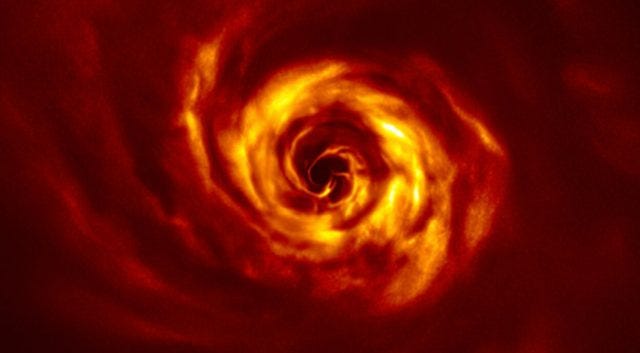Exploring the Birth of a New Planet in a Distant Solar System
Written on
Chapter 1: The Quest for Planetary Formation
Scientists have discovered thousands of exoplanets, largely due to advanced instruments such as the Kepler Space Telescope. Each new planet we study enhances our understanding of planetary development throughout the cosmos. The ultimate goal in this field is to observe planets as they form, and astronomers may have identified a prime candidate for such observation. The European Southern Observatory (ESO) has unveiled images of a young solar system displaying swirling gas that could indicate the onset of planet formation.
Astronomers are confident that planets develop within the dust and gas discs surrounding young stars, yet previous imaging efforts have lacked the clarity needed to reveal the small vortices that suggest a planet is emerging. A few years ago, the Large Millimeter/submillimeter Array (ALMA) examined a star known as AB Aurigae, located 520 light-years from Earth. The findings hinted at minor disturbances in the primordial disc, suggesting that planetary formation might be underway. The ESO aimed to confirm these findings using the Very Large Telescope (VLT).
Section 1.1: The Role of Advanced Imaging
The VLT is equipped with a cutting-edge adaptive optics tool called SPHERE (Spectro-Polarimetric High-contrast Exoplanet Research), which enhances image quality and contrast, albeit within a limited field of view. This capability makes it particularly suited for examining individual stars closely. Between late 2019 and early 2020, the ESO executed an observational campaign targeting AB Aurigae, leading to the release of new images.

Section 1.2: Insights from the Images
The images of the AB Aurigae system reveal what appears to be the location of a nascent exoplanet. The orange swirl represents the gas and dust orbiting AB Aurigae, while the darker region in the center is roughly the same size as Neptune’s orbit around the Sun. Despite SPHERE’s capabilities, we cannot zoom in further without losing resolution. However, this level of detail is sufficient to suggest the presence of a potential young planet. The prominent "twist" noted in the images aligns with the characteristics astronomers expect to see at this stage of a planet's development. Over time, materials will accumulate, exerting gravitational forces on their surroundings, eventually leading to the formation of a spherical body—what we would recognize as a planet.
Chapter 2: Future Observations and Discoveries
The ESO is in the process of constructing the 39-meter Extremely Large Telescope, which promises to enhance the capabilities established by ALMA and SPHERE. When operational in 2025, this telescope should provide an even closer examination of the potential young exoplanet. Additionally, the upcoming James Webb Space Telescope may offer unique insights, benefiting from its orbital position despite having a smaller mirror.
The first video titled "A young planet may be nestled in this dusty spiral" provides an overview of the discovery and its implications for understanding planetary formation.
The second video, "A World We Never Knew: Scientists Unearth Shocking Secrets About Our Planet," explores the broader context of planetary research and its significance for understanding our own planet.